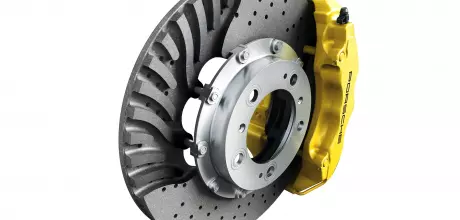How and why are Porsche Carbon Ceramic Brakes fitted to high-performance 911s so effective?

Unveiled at the 1999 IAA show in Frankfurt, Porsche Carbon Ceramic Brakes – PCCBs for short – first appeared on the 996 model GT2 of 2001. This was the first production sports car to use the technology.
Disc brakes may have been patented in 1902, but it took until the middle of that century for production cars to perfect the technology, including Porsche’s development of the ventilated disc brake, first used on the 906-8 Bergspider of 1965 and utilised on the 911S the following year. Brake development continued, ultimately using a carbon ceramic composite for the disc material.
Brakes convert kinetic energy into heat, through the friction utilised to make them function. The brake pads push against the spinning disc, the disc rotation is metered and the energy converts into heat. That heat causes fade, or reduced brake effectiveness – which is precisely the concept that the Bergspider’s internally drilled discs appreciated to gain their effectiveness. Cast iron has typically been used as a disc material, but the downside is weight and the amount of heat they can tolerate, then dissipate, to remain at maximum effectiveness. Drilling and ventilation helps, but only to a point.
This is where carbon ceramic brakes step in. Carbon is much more stable than iron and doesn’t expand as much. It’s also considerably lighter. Combining carbon fibre with silicon carbide and silicone for disc material results in a balance of wear, performance and stable characteristics through pressure and resistance, together with the all-important temperature loadings. This means that compared to cast iron, PCCB has a thermal expansion co-efficient of between 1 and 3.5, compared to that of 9 to 12 for cast iron, and under friction load, thermal stability is 1,350°C, compared to 700°C.
PCCB discs are made by carbon fibres of defined thicknesses and length. They receive a protective coating and are then pressed with a binding resin into a mould at high pressure. Heating this resultant disc to 900°C carbonises it. The disc is then siliconised by heating in a vacuum to 1,700°C. It’s then secured to the car’s wheel hub.
When driving, PCCB gives a low wear rate, consistent high brake performance and superior pedal pressure feel, while reducing unsprung weight over standard discs and pads. Even when not utilising the maximum performance envelope of the system, you’ll undoubtedly appreciate another asset of PCCB: it generates substantially lower amounts of brake dust.

